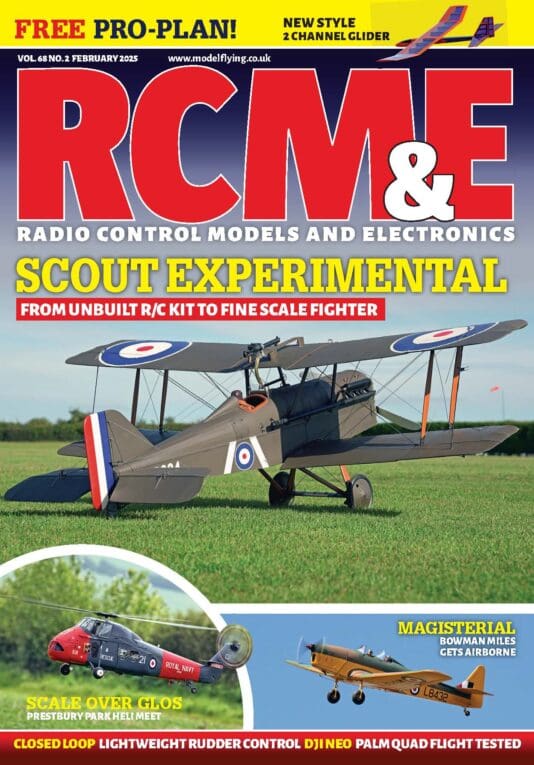The air brakes can be added by the pilot according to preference.
Now I have to be honest with you, I’m no hot-shot 3D pilot but I can prop-hang a bit and was attracted to the 4-Site simply due to the fact that it’s a slow flying machine. You see, despite being tagged as suitable for indoor flight, many RTF indoor models are simply too fast under a roof, so the hope was that the 4-Site would fit the bill in being slow and aerobatic.
The model is a smaller version of E-flite’s 4-Site F3P machine, a popular indoor and calm outdoor precision aerobat, itself introduced last year. This micro version is made from stamped foam that E-flite say is lighter, stiffer and more durable than standard sheet foam. The main parts are re-inforced with carbon rod and the machine factory fitted with Spektrum micro 4-channel radio, in particular using new long-throw servos that provide more control surface movement compared say, to the little Parkzone Sukhoi also launched last year but soon to see these units in a revised edition.
The UM 4-Site is available in one of two versions, this Plug’n’Play (PNP) variant or the Bind’n’Fly (BNF) set which adds two 150mAh, single-cell Li-Po batteries and a useful multi-charger. I bought this PNP version simply on the basis that it’s cheaper and I already have plenty of single-cell batteries only to realise that the machine flies with standard 120-130mAh cells but far, far better with higher ‘C’ rated cells such as the, difficult to find, 150mAh E-flite cells or the Intellect 130mAh 25C (£7 for 2) cells that I managed to find at a local shop. In fact the performance is so much better that, for 3D, only these higher ‘C’ rated cells are going to provide the grunt required.
 These long-reach servos certainly ensure there’s plenty of control surface movement.
These long-reach servos certainly ensure there’s plenty of control surface movement.
The model is supplied with E-flite’s typically thorough instruction manual which suggests a DX6i transmitter or better with which to fly the model. It’s good advice as, without exponential, the DX5 just isn’t really up to the task.
Binding is a simple task and the flying set-up advice is worth noting, especially the suggested expo’ settings. Out of the box, my pre-built model had a slight slant in the way the wing had been glued to the fuselage (when viewed from above). It’s not something that this fledgling 3D pilot can say has affected the flying performance to any degree but it’s also not a condition that any indoor contest pilot would put up with.
FLYING
I think it’s fair to say that this is a model that needs to be ‘flown’ all the time. The first mistake I made was in assuming the model could be trimmed for a more precise mode of pattern type flying, so allowing me to introduce a few 3D tricks along the way. Big mistake. The 4-Site isn’t really interested in playing this game – it’s pretty much 3D or bust from the word go.
My first few flights therefore were a little frustrating as I started to realise that a standard single-cell Li-Po, such as I’ve used with my ParkZone Vapor and P-51, wasn’t cutting the mustard and that the model’s flying remit was very much aimed at the 3D repertoire. These facts understood, new batteries secured, I was ready to rock and roll.
 The more I’ve flown the model so the more the battery has gone as far forward as possible.
The more I’ve flown the model so the more the battery has gone as far forward as possible.
Enjoy more RCM&E Magazine reading every month.
Click here to subscribe & save.
Keeping the model in the air is easy, it flies slowly and slower still with the air brakes added to the wing cabanes. These do their job well but do serve to negate aileron control effectiveness so it’s a case of fit ’em and see. The model has a tendency to sit on it’s tail in the air, a trait that I’ve taken to be an intentional result of the design remit and one that helps it through rolls and rolling circles where virtually no height seems to be lost and transition to the hover or prop-hang. That’s said, the more I’ve flown the model so I’ve moved the battery as far forward as it’ll go, the UM 4-Site just seems to fly better this way.
One unwanted tendancy seems to be the model’s reluctance to turn with ailerons alone, application of rudder always being required – as I say, you’ve got to ‘fly’ this one.
A championship winning pilot kindly gave me the chance to fly his perfectly set up indoor freestyle machine at a recent indoor session and I let him fly this model. It was a bit of an eye-opener. His model was easy to prop-hang and made me realise that while the UM 4-Site is fun for what it is, it is just that, a bit of fun but but perhaps not the weapon of choice for serious indoor 3D pilots. It’s cheap though and can fly in small spaces where bigger models will struggle but just make sure you use cells with a bit of kick.
- Check out the forum link below for other user comments and opinion.
DATAFILE
Name: Ultra Micro 4-Site
Manufacturer: E-flite
UK distributor: Horion Hobby UK, 01279 641097, www.horizonhobby.co.uk
Street price: Approx £65 for the plug ‘n’ play version or £90 for the bind ‘n’ fly version
Wingspan: 15.2″ (387mm)
All-up weight: 1.25oz (35.5g)
Article Tags:




